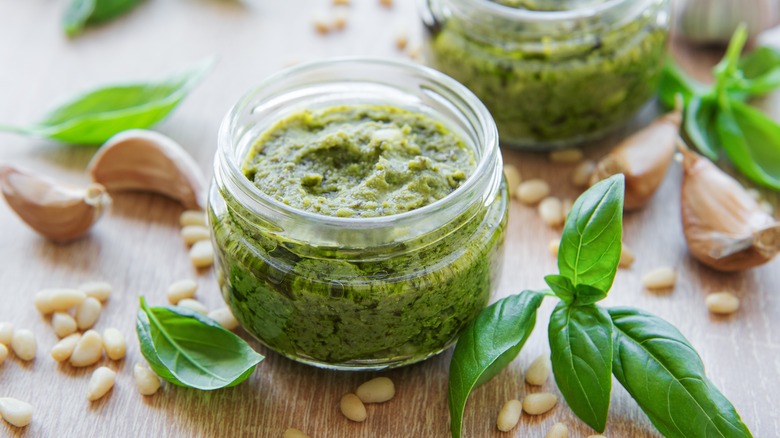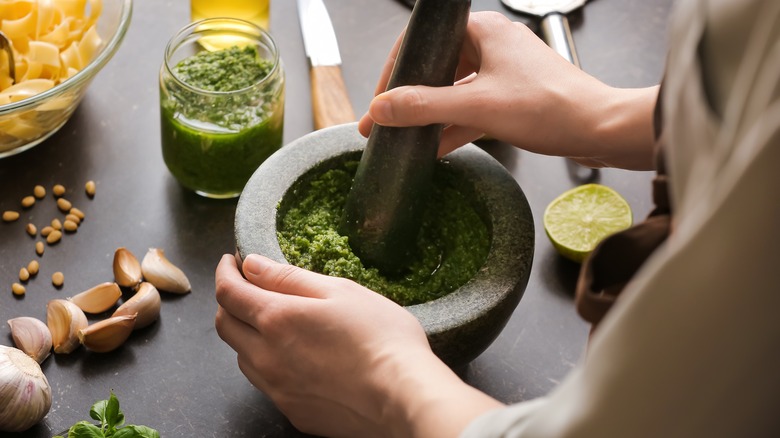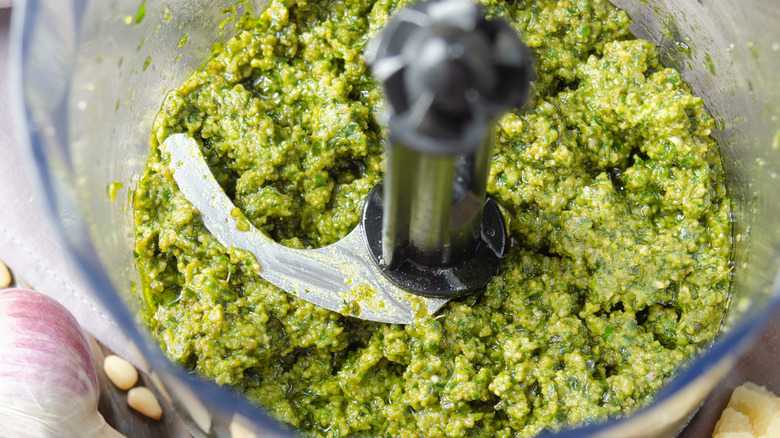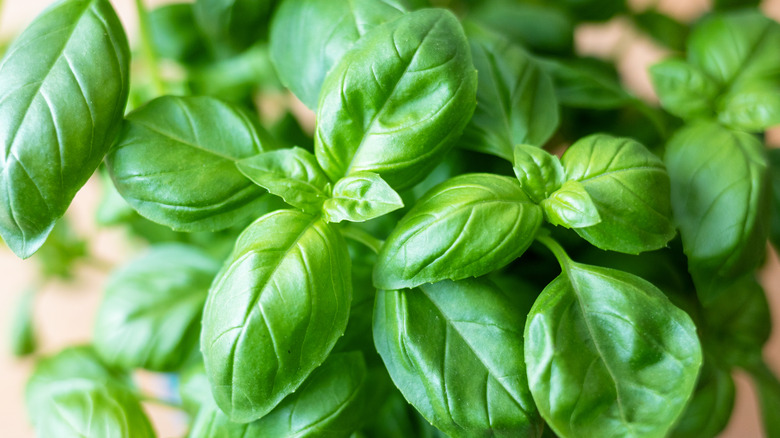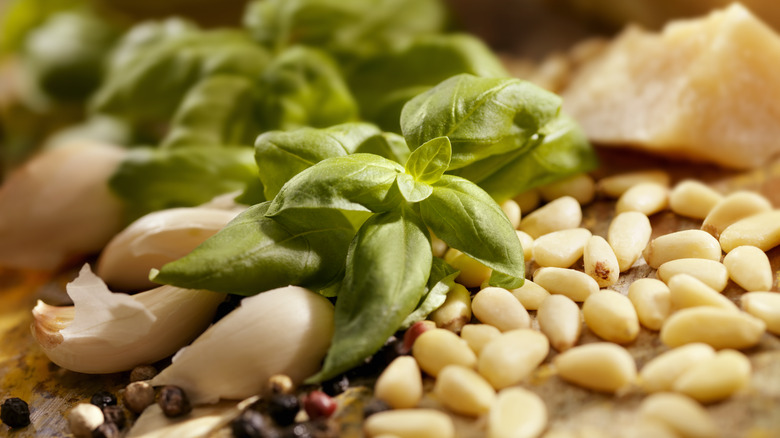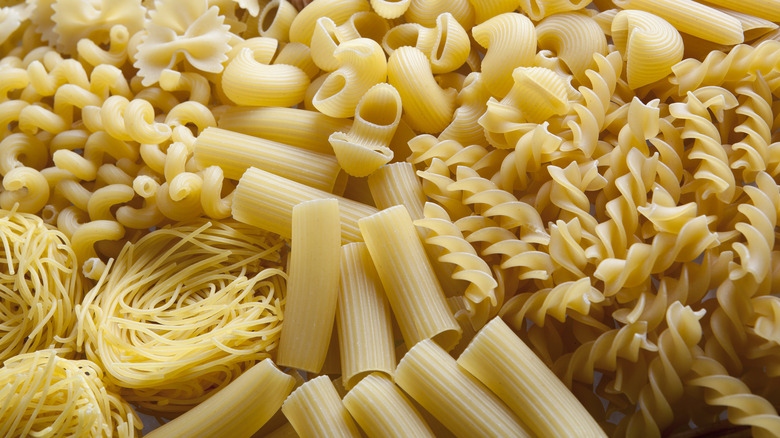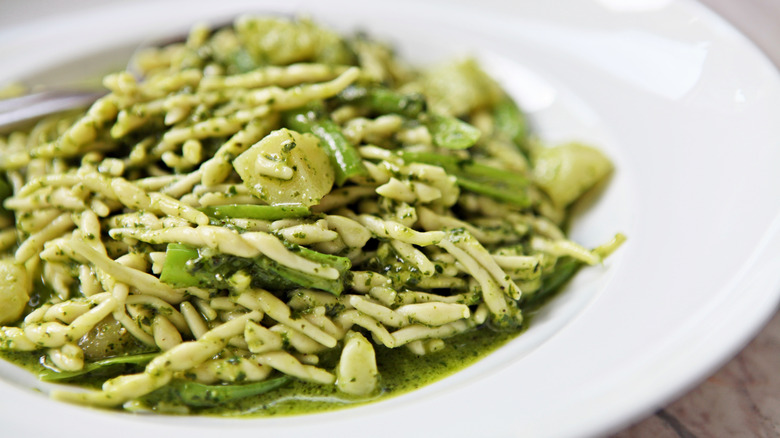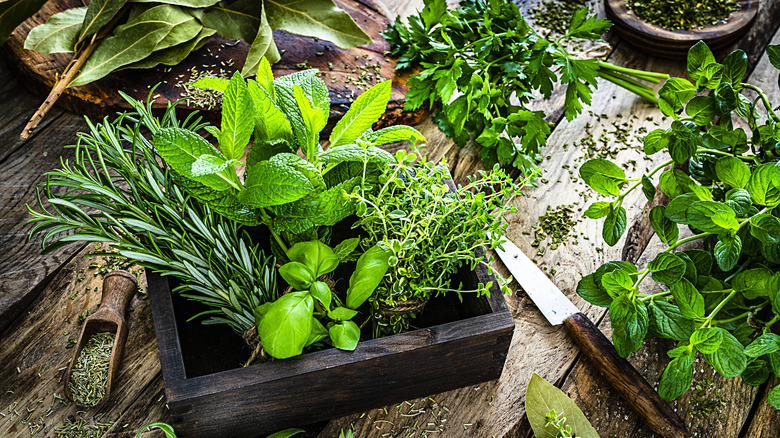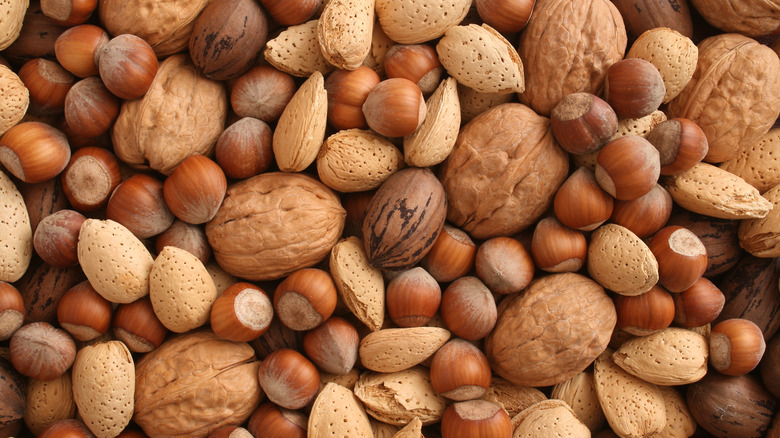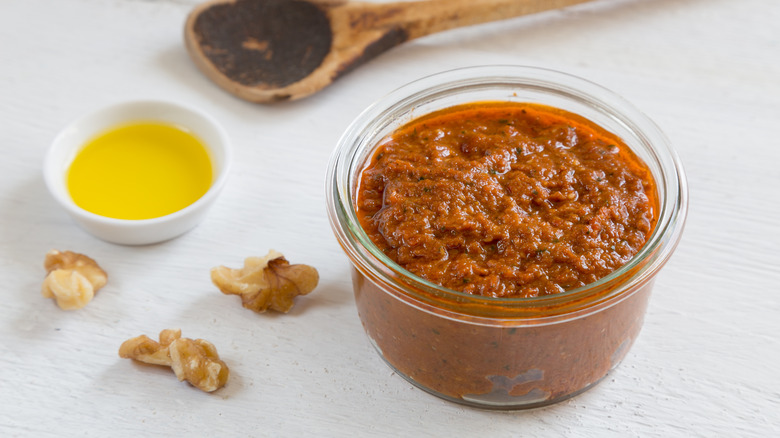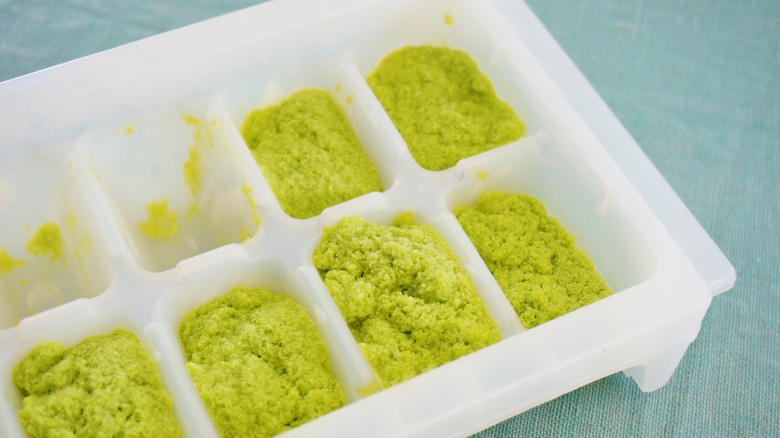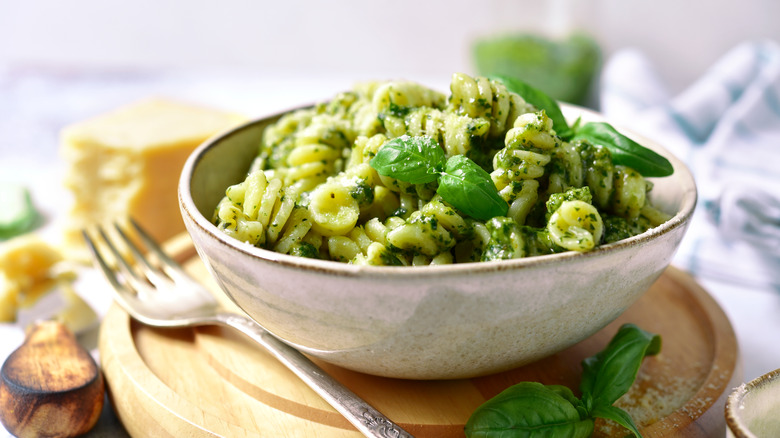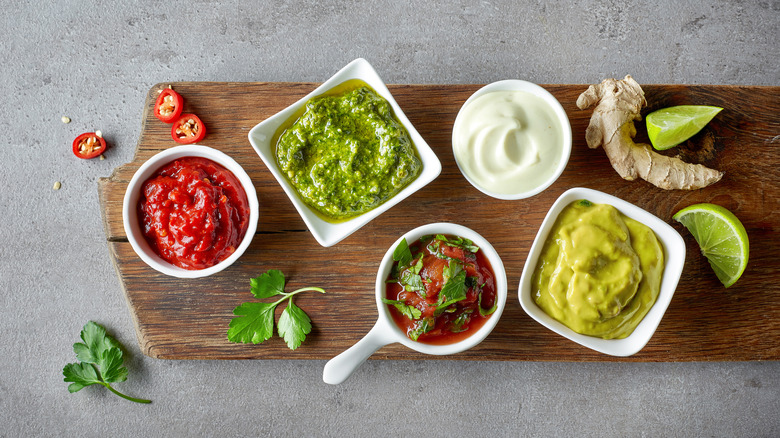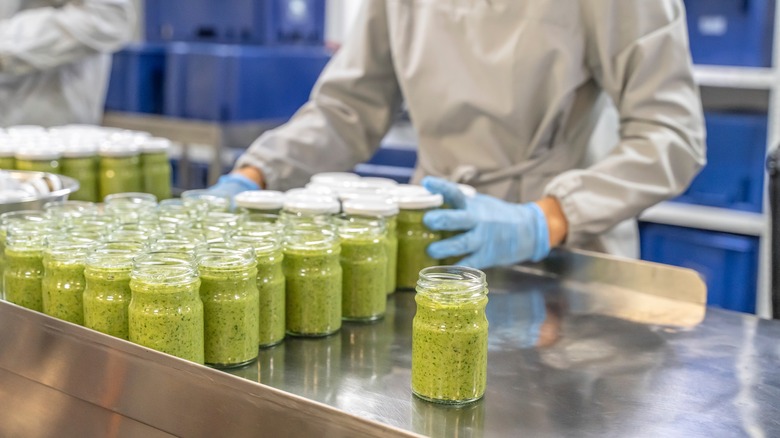14 Tips You Need For Making The Best Pesto
For many people, the word pesto brings to mind the fragrant, creamy, rich, and garlicky pesto alla genovese, a bright green sauce from Genova in the region of Liguria in Italy. However, the ancient origins of pesto stretch all the way back to the time of Romans with moretum, a sauce made from a mixture of herbs, olive oil, cheese, and salt. Another recipe called agliata hails from the Middle Ages in Italy and calls for mixed herbs, garlic, olive oil, bread, red wine vinegar, and salt. Today, many variations of modern pesto can be enjoyed, including red and orange versions from Southern Italy and similar green sauces from all over the world.
A versatile condiment, pesto is traditionally made by hand: Garlic and pine nuts are ground with a mortar and pestle, and then basil and salt are added. Grated Parmigiano-Reggiano and pecorino cheeses are mixed in, followed by a generous pour of extra virgin olive oil. The result is a decadently rich, creamy, cheesy, and aromatic sauce that can dress anything from pizza to canapés to roasted meat.
If you've only tried store-bought pesto, rest assured it's not difficult to make at home, and your extra effort will be rewarded. Our tips will help you make the best pesto recipe that you'll turn to time and time again.
Grind pesto by hand in a mortar and pestle
For pesto with authentic flavor and texture, make it by hand in a mortar and pestle. It's true that grinding the ingredients by hand takes more effort. While it's hard to get the sauce as smooth as a food processor makes it when you crush it by hand, that grainy texture is an important part of traditional pesto.
One enemy of pesto is heat, which turns the brilliant green basil black. When the food processor is running, the blade gets warm, and this heats up the delicate basil leaves. The food processor also grinds the nuts a little too well, bringing them closer to nut butter. Plus, the food processor blade will cut the lymphatic veins of the basil leaves cleanly, which doesn't benefit the flavor.
It's important to grind the pesto in a circular motion on the sides of the mortar rather than pounding it all into the bottom. This may seem rather picky, but moving the pestle this way will slowly tear the leaves, allowing their flavor and scent to infuse the sauce.
Carefully use a food processor
Not everyone has the equipment or the time to make pesto by hand. Using a food processor is a decidedly more convenient method that many people prefer, both around the world and in Italy. You can also use a blender since the generous amount of oil in the recipe will provide enough liquid. It's true that grinding the ingredients by hand produces a pesto with certain desirable characteristics, so don't just toss everything in the food processor and start blending away.
The machine can easily make the pesto too smooth, so to preserve the grainy texture of classic pesto, pulse it a few times until it just comes together instead of letting the machine run for a minute or two. Instead of adding the nuts first, save them for last. This will prevent them from getting overprocessed and help them retain their graininess.
The last consideration is heat. The fast whirring blades can generate heat and warm up the basil, making the leaves turn dark. Pulsing conservatively will help. You can also chill the blade and bowl for about an hour in the refrigerator before you start.
Treat the basil leaves delicately
For an authentic pesto with an unforgettable taste, use true Genoese basil, which is so important to the pesto alla genovese recipe that it's become a symbol of Liguria. It's the quintessential pesto loved around the world. Basil is a member of the mint family, but Genoese basil is unique because it has no mint smell. This herb has been awarded the Denominazione di Origine Protetta (Protected Designation of Origin) classification, which highlights high-quality, locally grown products.
Other kinds of basil also have an irresistible aroma and will still work well. Be careful because basil leaves contain polyphenols, which are subject to oxidation and, therefore, blacken when exposed to oxygen. To avoid this, choose very fresh leaves that aren't discolored or broken, and treat them carefully. Wash them with cold water, because warm or hot water will wilt them. Then, carefully hand dry the leaves with a cloth, because wet leaves will darken, too. If you want to be extra careful, avoid washing the leaves altogether and just wipe each one with a damp cloth. These tips will keep the resulting pesto bright green.
Use the best quality ingredients possible
Pesto is a relatively simple sauce. The classic version calls for just six ingredients. What will make or break the flavor of all your hard work is the quality of the ingredients you use. Ideally, use small-leaved Genoese DOP basil, Ligurian extra virgin olive oil, Parmigiano Reggiano cheese (aged 24 months), and pecorino sardo cheese. If you can get them, you're in for a treat. In reality, some of these ingredients are hard to find outside of Italy (or the region of Liguria) and, if they are, they may be expensive.
This is no reason to avoid making your own pesto, of course. Grab the freshest basil you can find with undamaged, bright green leaves. The quantities of Parmigiano Reggiano and pecorino sardo in the recipe are small, so you can get away with choosing a good piece of one or the other. You can also use regular pecorino or parmesan cheese, but avoid those with anti-caking agents. Also, buy the best quality oil you can afford because you will definitely taste it; pesto for four includes over ⅓ cup of olive oil, and the better the oil, the better the final flavor will be.
Choose the right pasta shape
Pesto sauce can dress any kind of pasta, but for the best results, use the right pasta shape for making pesto. To keep the pesto dish local, choose trofie or trenette, two classic Ligurian shapes served with pesto in trattorias all over the region. Trofie is a short pasta with a spiral shape, and the twists and turns make it easier for the pesto to cling to the noodles, making each bite more flavorful. If you can't find trofie, other shapes with similar nooks and crannies like gemelli, fusilli, and casarecce work well.
Trenette pasta is a long, flat noodle that may seem pretty identical to linguine at first glance, but in reality, has a much thicker cross-section. They are also rough, which allows the sauce to cling to them even without nooks and crannies. Trenette may be rather difficult to source in other parts of the world. Go ahead and substitute linguine if you can't find it.
Make pesto with potatoes and green beans
There is a version of pasta with pesto that comes from Liguria that includes potatoes and green beans. It is traditionally served with long trenette or short trofie pasta. This is the dish that was recently made famous in "Luca," the Disney Pixar film, who hails from Genoa. It's a slightly creamier version of regular pesto because the potatoes release their starch into the pasta cooking water.
Any kind of potato that is suitable for baking will be fine for this dish, but make sure to use fresh green beans, not canned. You'll use a little less pasta per person than you normally would because the potatoes add extra carbs.
To make it, first, check the cooking time printed on the pasta package. You'll boil the potatoes in salted water for 12 minutes and the green beans for 10, so make sure you add the pasta at the appropriate time. Everything will be boiled in one pot of water and drained together. As with any pesto, reserve a small amount of the cooking water before you drain the pasta to pour in a little when you mix all the ingredients together at the end. The starchy pasta water will help the pesto coat the pasta evenly.
Experiment with different greens
While basil is definitely a classic, other herbs or greens can be used to make a delicious pesto. Arugula is a good choice for a spicy green instead of the basil in your recipe. Pesto also turns out great with spinach or kale. Almond mint pesto calls for spinach and mint in equal parts and subs almonds for the traditional pine nuts. A broccoli pesto recipe is another take on the classic that uses two cups of broccoli along with a cup of basil.
There are many fresh herbs available that can provide interesting flavors for pesto. Cilantro is a popular choice that stars in this cilantro pesto recipe. Some people don't like the taste of cilantro, so parsley will work just as well. In fact, Italian bagnetto verde is a green condiment similar to pesto but is chock full of parsley. Other kinds of herbs that work well are mint, dill, chives, and garlic scapes. If you use stronger herbs like dill or mint, just mix in a little of them with basil or parsley.
You can even leave the greens out altogether. Marò di fave is an irresistible Italian fava bean pesto made by grinding peeled fresh fava beans, garlic, mint, salt, and extra virgin olive oil.
Experiment with different nuts
There's no reason to only use the pine nuts found in original pesto recipes. In fact, there are good reasons not to stick to pine nuts in pesto. It's true that pine nuts are decadently creamy and delicious, but they're also pretty expensive, not always available, and have some sustainability concerns when sourced from Korea or Eastern Russia instead of the Mediterranean.
There are many versions of pesto that use other kinds of nuts — even in Italy. Walnuts and almonds are common choices. If you've never heard of walnut pesto, also known as salsa di noci, this Northern Italian specialty will be a real treat. Made in a mortar and pestle just like pesto alla genovese, this sauce contains walnuts, Parmigiano cheese, garlic, olive oil, and salt. Some versions add milk for creaminess or the inner white part of crusty Italian bread.
Pistachio pesto is another tasty choice. This Sicilian classic combines raw pistachios, lemon juice, olive oil, grated cheese, and garlic with a couple leaves of fresh basil, salt, and pepper for another rich take on pesto. If you're not a fan of nuts or have an allergy, you can easily use seeds like sunflower, pumpkin, or sesame seeds instead.
Try colorful Italian variations
You may be surprised to hear that pesto doesn't have to be green. There are other exquisite Italian pesto recipes that have beautiful red or orange colors, too.
Pesto alla siciliana means Sicilian pesto and has a rich red color from tomatoes. For this reason, it's also known as pesto rosso and, like most pesto recipes, it's easy to make. Instead of the basil and garlic, the main ingredients are fresh tomatoes and ricotta cheese, both of which make it nice and creamy. Some versions use sun-dried tomatoes, which add an even stronger flavor. You'll toast the almonds first and then blend them in a food processor with tomatoes, garlic, and basil. Add ricotta and Parmigiano cheese along with extra virgin olive oil and blend until smooth.
Calabrian pesto is also made with tomatoes and ricotta, but it features red bell peppers and is slightly spicy from the addition of peperoncino. Unlike other kinds of Italian pesto, this one is cooked. You'll heat red peppers, tomatoes, and red onions (ideally red Tropea onions) in extra virgin olive oil before blending and adding the cheese and peperoncino.
Use pesto on more than pasta
Pesto is truly a versatile condiment that can be used in infinite ways. Your creativity is the limit. This sauce is best known for dressing pasta like linguine, gnocchi, or Ligurian trenette and trofie pasta. It's also used as a filling for baked pasta like lasagna. But pesto can be used for so much more than pasta. It's fragrant, salty, creamy, and rich, which is perfect for adding concentrated flavor and goodness to a wide variety of foods.
Pesto pizza is a real treat, but top the pizza with pesto after it comes out of the oven. Anything that could benefit from a savory, creamy topping can be enriched with pesto. Try canapés with pesto, cherry tomatoes, and small mozzarella balls, or impress your guests by serving bruschetta with pesto, burrata, sun-dried tomatoes, and pine nuts. Many people enjoy spreading pesto on meat, like in this pesto pork chop recipe, which marinates the meat in pesto, or in pesto-roasted chicken genovese.
Store pesto properly
Make sure you store pesto properly to prevent it from turning an unappealing brown color. Homemade pesto will last for four to five days in the refrigerator, while opened store-bought jars will keep for seven to 10 days. Exposure to oxygen darkens its bright green color, so make sure you pour a small amount of olive oil on top of the pesto before you close the container and place it in the fridge. This will form a seal and keep the air out.
Pesto freezes surprisingly well, but like many frozen foods, the texture may change a little once defrosted. Making pesto at home takes some effort, so if you don't have time to make it fresh every time, or if you simply want to have a convenient stash of pesto at the ready, make a large batch and save it in the freezer for when you need it. Store-bought pesto has a long shelf life if unopened, so you're more likely to freeze homemade pesto, but leftover commercial pesto can also be frozen if needed.
You can fill ice cube trays or use any kind of small jar or container. Remember to leave a little space at the top for the mixture to expand. Frozen pesto will be good for six months.
Make a vegan pesto
There's no need to miss out on pesto altogether if you can't or don't wish to eat cheese. Classic pesto calls for grated Parmigiano and pecorino cheeses, but this sauce is easy to make vegan. The simplest way to do this is to just leave the cheese out. It's still very good with a strong flavor from the aromatic basil, creamy pine nuts, and rich extra virgin olive oil. You can add a little more salt to make up for the lack of salty cheese.
If you'd like to substitute the cheese with something else, one way to do this is to use tofu. These blocks can be crumbled and mixed in with the other ingredients. The flavor is pretty neutral, but it adds creaminess and body. Another way to replace the cheese is to use nutritional yeast. This is an inactive form of the kind of yeast used to make bread, and many vegans use it to replace grated cheese in various recipes because of its somewhat cheesy flavor and natural source of vitamin B-12. Finally, you can replace the cheese in pesto with white miso paste for extra umami flavor.
Get inspired from around the world
Although they're called by different names, pesto is similar to many other green sauces from around the world. International green sauces can be a source of inspiration for your own version. The one that's probably the closest to pesto alla genovese is French pistou sauce made with fresh basil, garlic, and olive oil (just like Ligurian pesto), but it leaves out the cheese and pine nuts. The French use the sauce to top soupe au pistou, also known as provencal vegetable soup.
Frankfurter grüne soße, or Frankfurter green sauce, hails from Germany. It mixes seven herbs (garden cress, parsley, sorrel, chives, borage, chervil, and salad burnet) with vinegar, salt, and sour cream. It's speculated that Italian or French merchants brought the sauce to Germany since green sauces were yet unheard of there.
Peru has a cooked version of pesto originally brought by Italian immigrants that morphed over the years into tallarines verdes peruanos, or Peruvian green noodles, which uses local cheese and milk and adds spinach to the basil. It's mixed with spaghetti and served topped with a steak.
Spruce up store-bought pesto
While nothing beats the freshness of eating pesto you made five minutes before boiling the pasta, sometimes it's easier to just open a jar. Purchased pesto can be very tasty but choose with care. Try to select pesto with minimal ingredients, real olive oil, or the kind found in the refrigerated section. Some brands use other oils, skimp on expensive or perishable ingredients like cheese and pine nuts, or add extras like sugar to make it last longer. And let's face it — after commercial jarring, the ingredients aren't as fresh anymore.
You can spruce up purchased pesto by adding just that — freshness. To recuperate the strong aroma of fresh basil, tear some basil leaves by hand before adding them to your sauce. You can add any of the pesto's original ingredients to enjoy the flavors you love. Add crushed or minced garlic or use roasted garlic for an even stronger flavor. Sprinkle in some Parmigiano-Reggiano or pecorino cheese for savory goodness, or add any kind of crushed nuts. If it becomes too solid, pour in a little extra virgin olive oil to give it a more liquid-y consistency.
